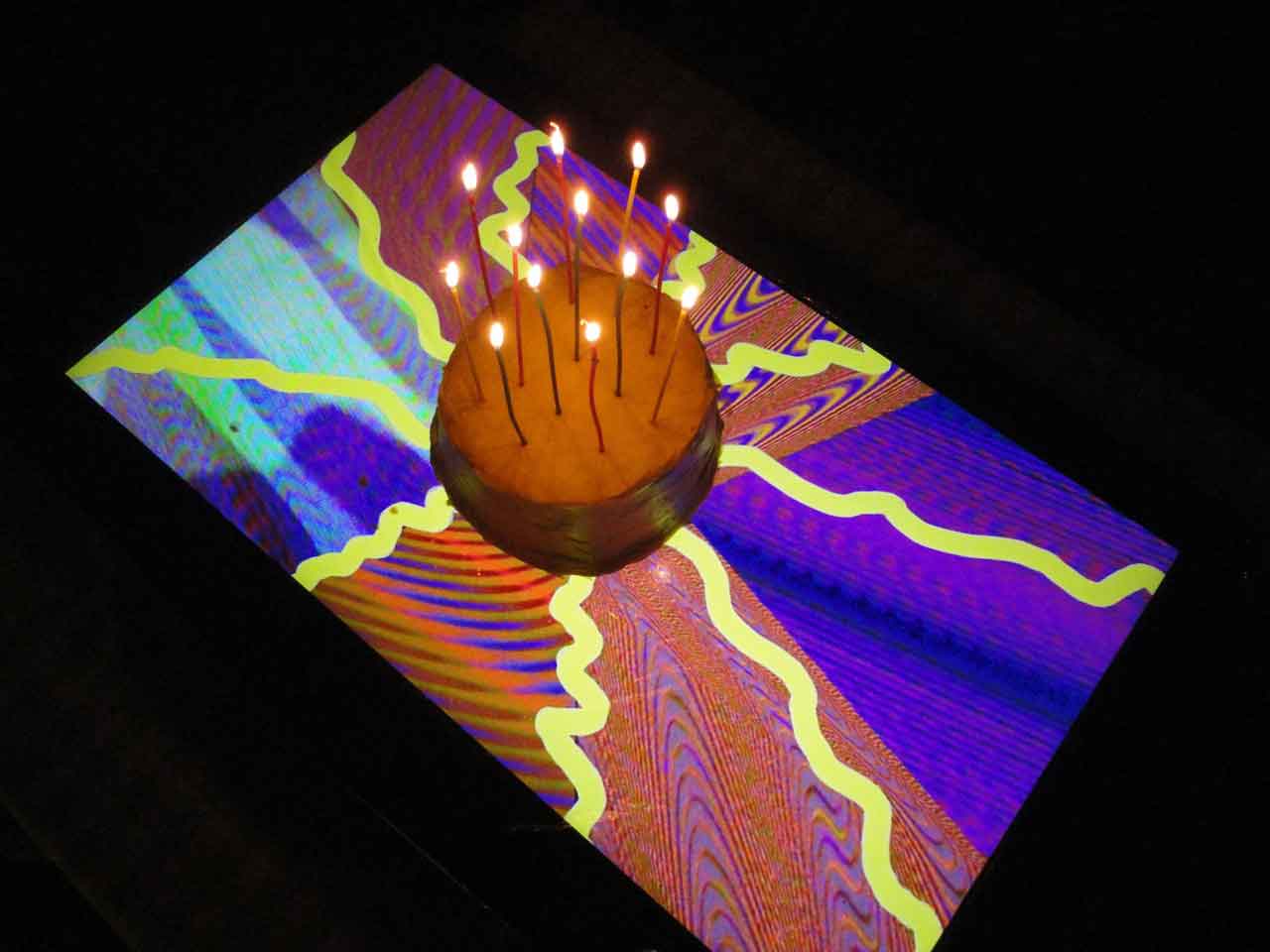Whether it’s a cathode ray tube, liquid crystal display, Nipkow disk, organic light-emitting diode, or plasma screen, the telly is a playground for media artists.
We’re thrilled to offer these reversible modications for your TV devices. We worked with friends to design these hacks with a social component, to enhance your house or office party. No soldering required!
HitIt!
Materials & Tools
- Computer running Processing software
- Kinect sensor and an AC power/USB adapter for older models
- TV or monitor connected to computer
- HitIt! project code
A collaboration with Ron Rosenman, founder of ThisThatLab (thisthatlab.com), this is a quick video game that’s fun to play and to watch. Use the existing soundtrack or and play your own sounds. We kept the images low-res; you can switch them for anything you want. Set it up in a space with plenty of room for swinging arms and jumping around.
1. Install the software. Install Processing from processing.org/download. Download the HitIt! project code and put the folder into your Processing sketches folder. Install the OpenNI/Kinect library, following the instructions at code.google.com/p/simple-openni/wiki/Installation.
2. Enable multiple hands. On a Mac, change the .ini files at /usr/etc/primesense/XnVHandGenerator/Nite.ini and at /usr/etc/primesense/Hands_1_5_2/Nite.ini to look like this:
[HandTrackerManager]
AllowMultipleHands=1
TrackAdditionalHands=1
On a Windows PC, make the above changes to the file C:Program Files (x86)Prime SenseNITEHandsDataNite.ini.
3. Plug the Kinect in. Into the computer, and also the wall if needed.
4. Calibrate the game. Open Processing and launch the HitIt! game sketch. Wave your arms until the system tracks you: you’ll see green and red trails following your hands. If it’s not tracking both hands, try clapping, waving both hands, or jumping up and down.
5. Start the game. Once you’re tracked, hit the red spot with your red hand to start the game. Sprites (e.g., pirates, monkeys, boomboxes, robots) will appear, and your current target will be either red or green.
6. “Hit” the images. Swat the target sprites by swinging your hands, using the tracking with the same color as the highlighted sprite. You’ll notice the sprites growing as you move through the game, and you’ll get feedback when you complete a round.
7. Party! You and your friends can take turns, round for round and hit for hit.
8. Modify the game. Make your own sprite images or sound samples and substitute them into their respective folders in the data folder. To make a sprite, create 4 versions (red, green, blue, white) as PNG files. Replace existing files while keeping the same names, or change the code to read your new files directly. Other challenges: 2 players simultaneously, multiple active sprites, or changing sprite behavior.
Static Cling
Materials & Tools
- TV, tuned to “noise” A cathode ray tube (CRT) works best, but a plasma or LCD screen can be OK too. If you’ve got an analog TV, tune it to an empty channel; otherwise, use a video clip of TV noise (or download ours).
- Vellum, translucent, in different colors. We used Chartham Color Translucent Vellum Paper.
- Tape, transparent
- Scissors
A collaboration with New York-based artist and musician Oliver Lyons, this awesome visual effect breaks the TV’s light into tiny flickering RGB light splashes, transforming it into a delicate light sculpture.
1. Cut the vellum. Make long strips about 3″ wide and as tall as your TV monitor.
2. Tape the vellum. Tape the strips at the top and bottom, flush against the screen, leaving a 1mm gap between strips.
3. Play the TV noise. The gaps will break the TV’s light into brightly colored RGB dots. They flicker wildly in a way you don’t notice when staring at a screen full of TV noise.
4. Embellish. Add different-colored layers, or create space between vellum and monitor to make cool shadowy effects.
5. Party. Cut pieces of vellum and have your guests create their own patterns. Static electricity will hold these in place for minutes.
Serving PlaTVer
Materials & Tools
- TV, plasma or other flat screen
- Computer or DVD player
- Cling wrap
- Assorted raw veggies and dip, or a birthday cake
- Videos of veggies and cake.
A collaboration with artist Tanya Bezreh (tanyabezreh.com), this hack transforms a screen into something delicious! Your guests are invited to be completely tactile with the screen.
1. Flip your flat-screen on its back. Cover the surface with cling-film plastic wrap. to keep crumbs from sticking in the corners.
2. Play the video clip. Spin and Grin for a birthday cake, and Crudité Kaleidoscope for veggies and dip. Play the QuickTime clips from a computer or burn them to a DVD (make sure to loop it). Or make your own clips: chips and salsa are a hot item at parties, or a video bar (beware spilled drinks!).
3. Position the food on the screen. Put the TV face up on your serving table. It’s a giant food platter! Place the cake in the center. Place veggies in any pattern you like.
4. Party! Your guests grab snacks while they feast their eyes on the video platter.
5. Clean up. Use a handheld vacuum cleaner.











